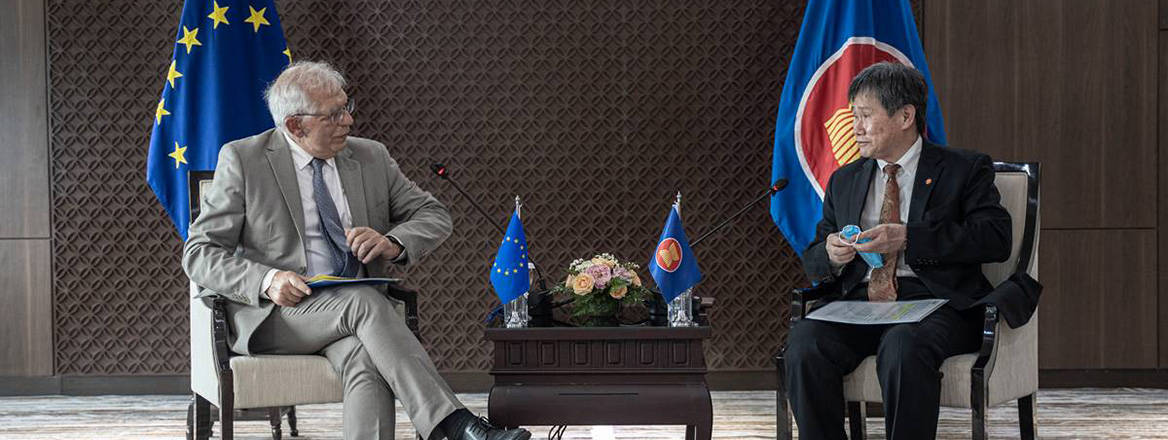The EU’s Indo-Pacific Strategy is Good News for ASEAN
A few short years after the US embraced the term, the Indo-Pacific is now an irreversible regional construct, as recent actions by the EU indicate. Indeed, the EU’s adoption of the term may represent a significant step forward in promoting the values that underpin the free and open Indo-Pacific order.
EU Policymaking
After more than four years’ silence on the issue, the EU recently released an official policy declaration on the Indo-Pacific. On 19 April, the Council of the European Union – the body responsible for developing the EU's foreign and security policy, based on European Council guidelines – approved a strategy for boosting multi-pronged and systematic cooperation in the Indo-Pacific. The Council also tasked the High Representative – the EU’s top diplomat – and the European Commission with issuing a Joint Communication on the Indo-Pacific by September. It is also important to note that apart from ASEAN, the EU is the only regional organisation to have officially endorsed the use of the term ‘Indo-Pacific’.
Like ASEAN (where Indonesia took the lead in promoting the Indo-Pacific construct), the countries leading the push for an EU Indo-Pacific strategy – Germany, France and the Netherlands – first announced their policies at the national level. These countries, particularly Germany and France, are not only leading European powers wielding significant influence over the EU, but also have considerable economic and diplomatic influence in the Indo-Pacific region.
France and Germany
Since France is geographically a part of the Indo-Pacific (because some of its overseas territories are in the region), any short- or long-term change in the Indo-Pacific economic and strategic equilibrium would have direct implications for the country.
Germany has robust economic ties with all three of Asia’s biggest economies – China, Japan and India. Of late, Germany has stepped up collaboration with Japan and India. German investment and business cooperation have also been an important dimension for economically prosperous and forward-looking Southeast Asian countries such as Malaysia and Singapore. The Dutch, too, retain a considerable business presence in Southeast Asia.
The influence of the Franco-German-Dutch trio in shaping the EU’s approach towards the Indo-Pacific can be seen in the EU’s embrace of the term ‘Indo-Pacific’, even though some of the other 24 members of the bloc remain ambivalent or take no stance on the term in their individual foreign policy pronouncements.
The Smart Approach
The EU has taken smart, systematically planned steps before formally throwing its hat into the Indo-Pacific ring.
In 2018, the EU launched its connectivity strategy, which was more comprehensive than the US-led ‘Blue Dot Network’ initiative in terms of issues covered. Unlike the Blue Dot Network, the EU’s strategy goes beyond security and connectivity, spanning issues such as the environment, climate change, democracy and human rights. In many ways, the initiative is a response to China's Belt and Road Initiative (BRI), and aims to provide a viable rules-based alternative to the BRI.
The EU–ASEAN strategic partnership, signed in December 2020, was another landmark step in the construction of the EU’s Indo-Pacific strategy. Complementing the connectivity strategy and strategic partnership were two important free trade agreements (FTAs) signed with Singapore and Vietnam in 2019. After EU–ASEAN FTA negotiations were suspended in 2009, the EU decided to pursue bilateral agreements with ASEAN members. Moreover, ASEAN’s major dialogue partners – Japan (Economic Partnership Agreement, 2019), South Korea (FTA, 2015), Australia (partnership framework, 2008; FTA negotiations ongoing since 2018) and New Zealand (partnership agreement, 2017; FTA talks ongoing since 2018) – already have trade arrangements with the EU. At the same time, EU–China relations have recently seen a number of negative trends, including mutual sanctions, controversies surrounding 5G and Chinese technology giant Huawei, and issues related to human rights violations in China. These incidents have also alerted EU members to the flaws in the liberal international order which China has systematically exploited.
Robust Approach
Previous efforts by the EU – and the US – to change China through dialogue and engagement have failed. The EU is mindful of this, and is seemingly gearing up for a more proactive and direct approach, as manifested in the European Parliament Foreign Affairs Committee’s recently released China strategy. The EU’s suspension of the ratification process for the Comprehensive Agreement on Investment with China, along with its recent vocal criticism of China’s human rights violations in Xinjiang and Hong Kong and the country’s aggressive posture in the South China Sea, demonstrates the EU’s nuanced two-fold approach to China. The focus is still on rules rather than the actor, with the EU stressing the ‘promotion of democracy, rule of law, human rights and international law’ but denying any specific bias against China. Additional elements include transparent trade and investment practices, and strict compliance with international law.
The EU’s Indo-Pacific strategy is good news for ASEAN and the rest of the Indo-Pacific region, as it adds a strong normative dimension to the Indo-Pacific system. Another potentially key normative function of the EU, which brings it into sync with ASEAN, is its attempt to steer clear of the rivalry between the US and China, despite the Biden administration’s efforts to achieve a coordinated US–European–Japanese response to China’s growing role in the Indo-Pacific.
The EU can bring several tangible gains to the table, the most important being the ‘normative dimensions of a rules-based and peaceful order’. These potential gains, however, depend on deft diplomacy and careful policy implementation – and this is where the EU’s future challenge lies.
The views expressed in this Commentary are the author’s, and do not represent those of RUSI or any other institution.
Have an idea for a Commentary you’d like to write for us? Send a short pitch to commentaries@rusi.org and we’ll get back to you if it fits into our research interests. Full guidelines for contributors can be found here.
Dr Rahul Mishra
Guest Contributor


